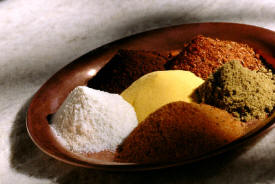|
Reclaiming The
Kitchen
|
|
|
Spices
 When you're first learning to
cook, the spice rack at the grocery store can seem awfully intimidating.
And if you follow the impulse to simply "throw a few things together"
more often than not you end up with flavors that clash rather than ones
that enhance your food. When you're first learning to
cook, the spice rack at the grocery store can seem awfully intimidating.
And if you follow the impulse to simply "throw a few things together"
more often than not you end up with flavors that clash rather than ones
that enhance your food.
Spice Families
There are collections
of spices that go well together, and then there are those that don't.
This is one place that cookbooks can really come in handy, not so much
because you want to follow the recipe exactly, but when you read the
recipes, you can get a good idea of what spices are often grouped
together and which ones clash.
As long as you stay within
one of these families you can feel free to
mix and match, and you'll probably have pretty good results.
Mexican
Chili powder (some
commercially available chili powder has other spices mixed into it, but
basic chili powder is simply red chilies that are dried and crushed into
a find powder.) Cayenne (use with caution... unlike basic chili powder,
this stuff packs a punch!) Cumin, Oregano, Garlic, Onion.
Italian
Basil, Oregano,
Thyme, Bay Leaf, Parsley, Garlic, Onion.
Indian
Turmeric, Garlic,
Coriander, Cardamom, Cumin, Sesame, Cayenne. A note on curry: curry is
not actually a spice, it is a collection of several different spices...
usually turmeric, cumin, coriander and sometimes garlic & cayenne.
ChineseGinger, Garlic,
Soy Sauce, Sesame, Cayenne.
Meats
Rosemary, Sage, Marjoram, Savory, Tarragon.
Salads & Dressings
Parsley, Sesame, Dill, Garlic, Chives, Tarragon. |
|